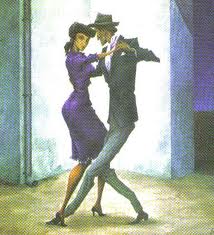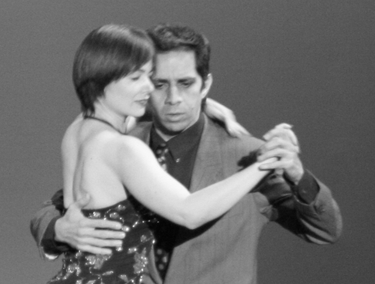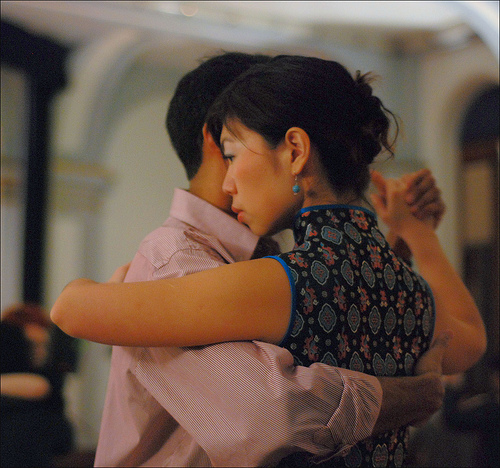The myth of the embrace
9th December 2010
- Introduction
- But which do I use?
- Who gets to choose the embrace?
- Coping with incompatibility
- And lastly
- Related articles
Introduction
(This is part of a series of "deconstructing the myth" articles - have a look at Speed: the myth of fast reactions and Grounded: the myth of balance, and Walking: the myth of "natural" for previous articles in this series.)
So, the embrace. Well, hmmmm...
There's a lot of myths (and indeed waffle) about the embrace.
Basically, a lot of the advice I can provide boils down to two guidelines
- Use the embrace which works best at the time.
- The man invites the embrace, the woman accepts / rejects / modifies it.
Of course, actually getting these two to work is the tough part - and hopefully this has not put you off reading the rest of the article :)
First, do the research
There is a reasonable amount of information about the embrace on this site. I'd recommend reading the Ghost Guide To Tango article to start with.
I've also covered some of the technical aspects of achieving the embrace in my class notes - here's a couple of links:
There is, of course, similarly a vast amount of information on the web on this area - again, some research is a good idea.
But which do I use?
So, OK, you've now done the research, you know the terms, you can achieve a reasonable close and open embrace.
But you're still no clearer as to when you use them, right?
Which is best?
There is no "best". It's like asking which is "best" out of Cuban or Colombian Salsa - or which is "best" out of Di Sarli and Troilo. They're both good, in different ways and contexts. So there's no "best embrace"; they all do different things. It just depends what it is you want to do - but bear in mind that embraces desinged for shows probably aren't a great idea for social dancing.
You can certainly - for example - create some lovely shapes with an open embrace:

My opinion
(Yes, this is my opinion, but it's not just something I made up - there's some thought gone into it.)
Personally, I feel that if you're dancing in a milonga to a traditional tango track (say, Di Sarli), you should dance in close embrace. Or, at least, you should have a very good reason not to do so. And frankly, if the reason is "I'm not comfortable in close", then you may not be ready for a milonga yet.
Similarly (or conversely), if you're dancing to a non-traditional track (say, Bajofondo), then it's completely reasonable to dance in open, as you're more likely to want to do pivot-based movements than walk-based movements, and open embrace enhances those movements.
(I wouldn't quite go so far as to say that if you're dancing to neo music you should dance in open embrace, but I'd certainly say that'd be my recommendation for most people).
Mix and match?
The problem with going from close to open (and back again) is that every time you return to close, you need to reestablish the connection. Mostly, this happens automatially, but sometimes you find you're both a little out-of-synch, so you have to take time to get back with each other.
So I'm not sure I'd advise doing too much mix-and-match in a single dance.
Who gets to choose the embrace?
Once you start getting into the complexities of embrace variations (open, close, apilado, weird, etc.), you do encounter / ask the question of "Who gets to choose?". Often, followers ask this with the silent caveat "...Because I really don't want to dance close with XYZ"
Two non-answers
My first answer to that question would be "If you're not comfortable dancing close with XYZ, then you probably shouldn't be dancing Tango socially with him at all - so, don't".
Also, from a certain point of view, the question doesn't make sense; or at least, it doesn't really matter. Because, what should happen is that people invite people who use the same embrace, so there should be no problem in real life. If you want close embrace, and you see someone dancing in close embrace 100% of the time, you should be able to approach that person with some confidence that their embrace will be compatible with yours.
However, I appreciate that both of the above are actually evasions - at least, from a certain point of view.
Plus, for those of us who are, ummm, lucky enough to dance in London, there are many occasions where the ideal never happens.
One answer
So, again in an ideal world, the invitation proffered by the man, in several parts:
- The man indicates the embrace by how he closes with the woman - how close / straight on / V etc.
- The woman can then accept, decline, or modify this invitation as they close in.
- Similar negotiations should happen with the man's left hand positioning and other subtleties.
- Finally, there's a bit of "tweaking" at the end, whilst both of you are settling in to the embrace.
So the man, as with other aspects of the dance, initiates and invites, and the woman, again, accepts / rejects / modifies.
Massive "modifies" caveat
That said, I think that the "modifies" side of things should be limited to "making it not uncomfortable" changes. I don't think that the woman should decide "actually, I want my free arm held up high, I like that style". Fundamentally, the man's embrace should be an integral part of his style - he should have developed it, refined it, and will dance best when using it.
So if you as a woman don't want to dance with someone of that style, then don't, but don't try to modify it for stylistic reasons, any more than you'd try to hijack a step because you wanted to do a different one. Or, if you find during the dance that you really can't deal with the man's embrace, it's probably better not to dance, or at most just have one dance with your partner.
The face thing
On the issue of "face touching" - this is entirely the woman's responsibility, including choosing to re-establish it if the embrace changes (such as by openning out for a giro). The man is not supposed to go "looking" for her with his head or meet her in the middle; it causes all sorts of problems.
Coping with incompatibility
How do you handle incompatible embraces?
An anecdote
Last night, I was dancing with a gorgeous woman. She was much in demand, and I'd been chasing her around the floor for about an hour, waiting for our "off times" to synchronise so that we'd get a chance to dance. I'd not danced with her for a few months, so I was eager to see how she'd progressed in the meantime.
Unfortunately for me, her progression seems to have been to develop the "V" style of embrace - that is close contact on the man's right / woman's left, but far more open on the man's left / woman's right.

And at the moment, I'm not really comfortable or even very familiar with that style - I prefer a simply full-on hug.

But it's practically impossible to impose such a style.
Don't get me wrong - she's a lovely dancer, she was very happy to dance with me, and we managed (after a few bad dances) to work out some form of embrace that allowed us both to have a good dance by the end. It's also likely that the fault was with me, not with her - I was trying to impose an embrace which she simply would not adopt.
So in hindsight, I should have adjusted to the style she offered (and I should learn how to dance in that style) if I want to dance with her, or I should have adopted an open embrace. Failing that, I should simply not ask her to dance.
An answer
If your embraces just don't work together, then you should - by proper Tango etiquette - give a "thank you" at the end of one dance.
In real life, I think that's harsh - as long as you're not actually in pain, then an extra couple of dances is only 5 minutes of your life. And who knows, you may persevere and find out that you can come up with a workable compromise for both of you.
And lastly
Getting the embrace right is a cornerstone of Tango dancing. If it's not right, it makes lead-and-follow far, far more difficult.
It's well worth learning and working on this - until it's right, it's much harder to lead and follow. So it makes sense to spend time getting this right, rather than trying to learn particular moves.
Like all technique, it's "boring" but it pays off.
~ David Bailey, 9th December 2010